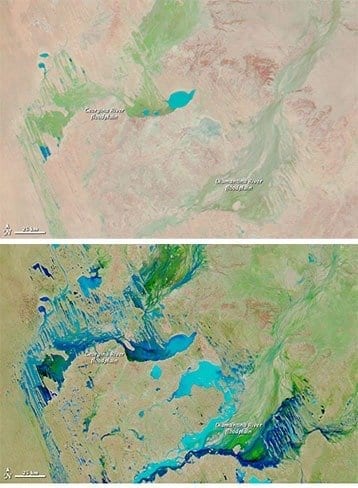
When enough raindrops fall over land instead of the ocean, they begin to add up.
New research led by the National Center for Atmospheric Research (NCAR) shows that when three atmospheric patterns came together over the Indian and Pacific oceans, they drove so much precipitation over Australia in 2010 and 2011 that the world’s ocean levels dropped measurably. Unlike other continents, the soils and topography of Australia prevent almost all of its precipitation from running off into the ocean.
The 2010-11 event temporarily halted a long-term trend of rising sea levels caused by higher temperatures and melting ice sheets.
Now that the atmospheric patterns have snapped back and more rain is falling over tropical oceans, the seas are rising again. In fact, with Australia in a major drought, they are rising faster than before.
“It’s a beautiful illustration of how complicated our climate system is,” says NCAR scientist John Fasullo, the lead author of the study. “The smallest continent in the world can affect sea level worldwide. Its influence is so strong that it can temporarily overcome the background trend of rising sea levels that we see with climate change.”
The study, with co-authors from NASA’s Jet Propulsion Laboratory and the University of Colorado at Boulder, will be published next month in Geophysical Research Letters. It was funded by the National Science Foundation, which is NCAR’s sponsor, and by NASA.
CONSISTENT RISING, INTERRUPTED
As the climate warms, the world’s oceans have been rising in recent decades by just more than 3 millimeters (0.1 inches) annually. This is partly because the heat causes water to expand, and partly because runoff from retreating glaciers and ice sheets is making its way into the oceans.
But for an 18-month period beginning in 2010, the oceans mysteriously dropped by about 7 millimeters (about 0.3 inches), more than offsetting the annual rise.
Fasullo and his co-authors published research last year demonstrating that the reason had to do with the increased rainfall over tropical continents. They also showed that the drop coincided with the atmospheric oscillation known as La Niña, which cooled tropical surface waters in the eastern Pacific and suppressed rainfall there while enhancing it over other portions of the tropical Pacific, Africa, South America, and Australia.
But an analysis of the historical record showed that past La Niña events only rarely accompanied such a pronounced drop in sea level.
Using a combination of satellite instruments and other tools, the new study finds that the picture in 2010–11 was uniquely complex. A rare combination of two other semi-cyclic climate modes came together to drive such large amounts of rain over Australia that the continent, on average, received almost one foot (300 millimeters) of rain more than average.
The Latest Bing News on:
Global Sea Level Rise
- Atlanta’s population could boom as people flee sea level rise, wildfires, and hurricaneson April 26, 2024 at 4:00 am
But sea level rise won’t be the only driver of migration. People are also likely to flee to Atlanta to escape extreme heat, wildfires, drought, and hurricanes elsewhere. (The city absorbed tens of ...
- Global warming could make tides higher as well as raising sea levelson April 26, 2024 at 3:00 am
In addition to the overall rise in sea level, the heights of tides are also changing as the oceans warm and separate into more distinct layers ...
- Indonesia’s Sea Level Continues to Rise, Small Islands Disappearon April 23, 2024 at 3:34 am
According to the Meteorology, Climatology and Geophysics Agency (BMKG), sea level in Indonesia has increased by 0.8-1.2 centimeters (cm) per year due to the impact of climate change.
- Warming up to climate change: Why does sea level rise matter?on April 22, 2024 at 11:15 pm
In this series of explainers, we answer some of the most fundamental questions about climate change, the science behind it, and its impact. In the eleventh instalment, we answer the question: 'Why ...
- Hidden threat: Global underground infrastructure vulnerable to sea-level riseon April 15, 2024 at 2:11 pm
As sea levels rise, coastal groundwater is lifted closer to the ground surface while also becoming saltier and more corrosive. A recent study by Earth scientists at the University of Hawai'i (UH) at ...
- Hidden threat: Global underground infrastructure vulnerable to sea-level riseon April 14, 2024 at 5:00 pm
"The IPCC 6th Assessment Report tells us that sea level rise is an unstoppable and irreversible reality for centuries to millennia," said Chip Fletcher, study co-author, interim Dean of SOEST ...
- sea level riseon April 3, 2024 at 5:00 pm
Seas are rising all over the world and the rate of sea-level rise keeps increasing as well; a new report says the low-lying coastal Tampa Bay area should expect at least two feet, but as... According ...
- El Niño Led To Spike In Global Sea Level Rise, NASA Analysis Showson March 27, 2024 at 5:01 pm
El Niño last year led to global sea level rise equivalent to dumping one quarter of the water from Lake Superior into Earth's oceans, according to a NASA analysis. “We've been tracking this El ...
- 2023 Witnesses a Notable Rise in Global Sea Levels, El Niño Contributeson March 21, 2024 at 9:42 am
An analysis spearheaded by NASA has observed a significant increase in the global sea level, with a rise of approximately 0.3 inches (0.76 centimeters) from 2022 to 2023. The sharp rise is largely ...
- Ocean heat, sea level rise and glacier loss: WMO report reveals how 2023 smashed climate recordson March 18, 2024 at 5:00 pm
The WMO’s latest State of the Global Climate report takes stock ... And as the chart below shows, the rate of sea level rise has been increasing. It more than doubled from 2.13 mm/year between ...
The Latest Google Headlines on:
Global Sea Level Rise
[google_news title=”” keyword=”Global Sea Level Rise” num_posts=”10″ blurb_length=”0″ show_thumb=”left”]
The Latest Bing News on:
Ocean levels
- Hermosa Beach panel to discuss LA sea levelon April 26, 2024 at 3:00 pm
Environmental reporter and Pulitzer Prize finalist Rosanna Xia, Heal the Bay president Tracy Quinn and Los Angeles County Beaches and Harbors Planner Warren Ontiveros will lead a panel ...
- 'Huge' Cocaine Levels Make Sea Life High in Popular Beach Bayon April 26, 2024 at 6:25 am
The drug has now been classed as an "emerging contaminant of concern" and may have been accumulating in Brazilian waters since the 1930s.
- Global warming could make tides higher as well as raising sea levelson April 26, 2024 at 3:00 am
In addition to the overall rise in sea level, the heights of tides are also changing as the oceans warm and separate into more distinct layers ...
- US Map Shows 'Hazard Zones' for Rising Sea Levels, Tsunamison April 25, 2024 at 2:06 pm
The NOAA map reveals the areas of the U.S. that are at risk of flooding from a variety of hazards, ranging from storm surges and tsunamis to high tide flooding and sea level rise. Red areas of the map ...
- From spies to sea-level rise, Venice’s history is enthrallingon April 25, 2024 at 6:57 am
Dennis Romano, an emeritus professor at Syracuse University in New York, embarked on this new history of the city with the notion that “deromanticising Venice does not strip it of its power. It makes ...
- China Map Shows Cities That Could Sink Below Sea Level By 2120on April 24, 2024 at 5:38 pm
Subsidence and rising sea levels pose a long-term crisis for China's heavily urbanized coast if left unchecked.
- Sea level rise could make tsunamis more destructive. Is Hawaiʻi prepared?on April 24, 2024 at 2:59 pm
Scientists developed Hawaiʻi's tsunami evacuation maps based on impacts of historical tsunamis. But how will future risks, like sea level rise, be calculated into the state's disaster planning? HPR's ...
- Shoreline model predicts long-term future of storm protection and sea-level riseon April 24, 2024 at 1:37 pm
Researchers in North Carolina have created a simulation model to analyze how coastal management activities meant to protect barrier islands from sea-level rise can disrupt the natural processes that ...
- From the coast to the deep sea, changing oxygen levels affect marine life in different wayson April 23, 2024 at 10:50 am
Earth's atmosphere maintains a constant level of oxygen, whether it is a wintry, rainy day or hot summer. Across the ocean, oxygen concentrations vary enormously between different places and over time ...
- Carbon Dioxide Levels Have Passed a New Milestoneon April 20, 2024 at 2:01 am
Evacuating Pets: When disaster strikes, household pets’ lives are among the most vulnerable. You can avoid the worst by planning ahead.
The Latest Google Headlines on:
Ocean levels
[google_news title=”” keyword=”ocean levels” num_posts=”10″ blurb_length=”0″ show_thumb=”left”]










